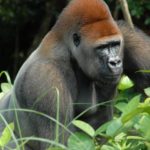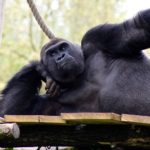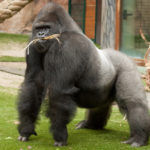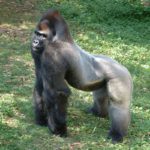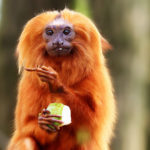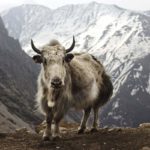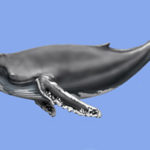Gorillas
 Gorillas are the largest anthropoid apes. They look awesome, but in reality they are completely harmless herbivores. The weight of the male is almost 250 kg, and the length of the body is 1.8 m and more. Female is twice as small and lighter than males. The constitution is massive with a strongly developed musculature. The head of gorillas is large, the face without wool, black, the eyes are deeply planted and widely spaced.
Gorillas are the largest anthropoid apes. They look awesome, but in reality they are completely harmless herbivores. The weight of the male is almost 250 kg, and the length of the body is 1.8 m and more. Female is twice as small and lighter than males. The constitution is massive with a strongly developed musculature. The head of gorillas is large, the face without wool, black, the eyes are deeply planted and widely spaced.
The nose is wide, the upper lip is short, the ears are pressed to the head, small. Torso with large belly, shoulders broad, arms long, bristles broad, thumb short, but can easily be contrasted with the rest. Brushes are used when manipulating, collecting food and building a nest. Legs of gorillas are short, feet with long heel. The coat is dense, short, black in color. Adult males have a small beard, and on the back there is a silvery band.
The gorillas move on four limbs. Young and small monkeys spend most of the time among tree crowns. They climb cautiously and slowly, sometimes, hanging on their hands, move on branches. Gorillas are smart enough for their weight. During the descent down the smooth trunks of trees, gorillas never collide, but follow strictly in the order of the queue. It is very rare to see gorillas walking on two legs.
The basis of nutrition of these monkeys is plant food. The most consumable plants include: a young lady, wild celery, nettle, blue pigeum fruits, bamboo shoots. Fruits and nuts are secondary food products, and animal food (mostly insects) makes up a very small portion of the gorilla menu. In captivity, young gorillas very quickly become accustomed to all human food. The massive jaws of these monkeys and powerful chewing musculature easily allow coping with bark, stems, roots, wood, as well as fruits and leaves. Drink gorillas do not have to, because the juicy greens contain sufficient for the animal the amount of moisture. Ponds and water in general, if possible, try to avoid, and the rain does not like.
In nature, gorillas live in the equatorial forests of central and western Africa, and mountain gorillas prefer the forested slopes of the Virung mountains. Monkeys are kept in small groups of 5 to 30 individuals, which consist of a male leader, several females and cubs. When the leader meets a single male, who wants to take possession of a harem, it is rare for a fistfight, and is most often limited to a demonstration of strength. In other animals, gorillas are never attacked, but only protected if necessary.
The first part of the day the monkeys are engaged in feeding. Then follows a slow walk in the forest. In the hottest time the activity of animals falls. Some for the afternoon rest lie on the ground, others build nests. Mothers put their children’s wool in order, teenagers and adults clean each other’s skin. Closer to the night, the male begins to build the nest from the folded branches and grass stems first, then other members of the community follow his example. Sometimes teenagers and females arrange their lodging for the night on the branches of trees. With the onset of darkness, any activity of gorillas ceases, and the herd goes to bed.
